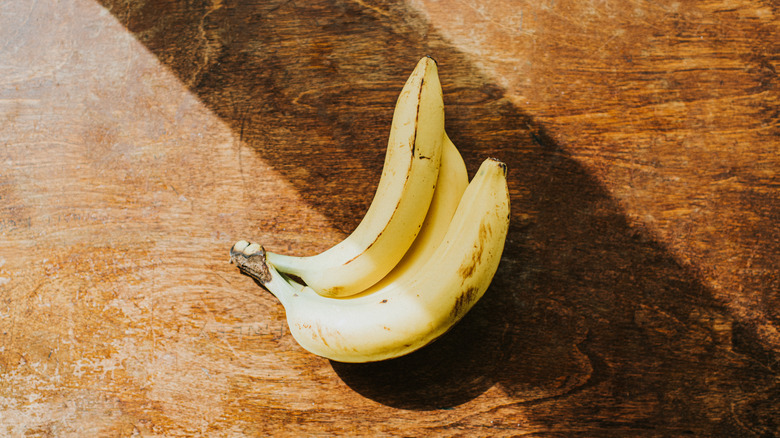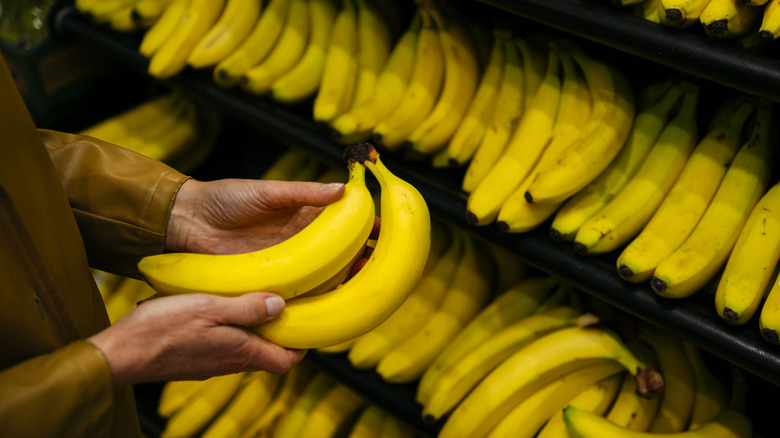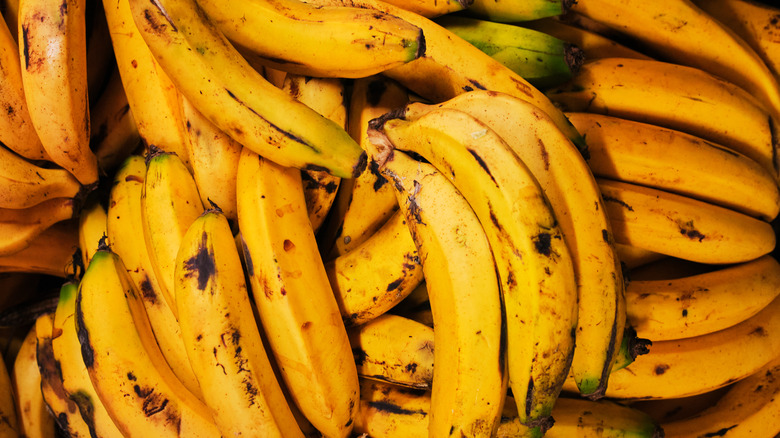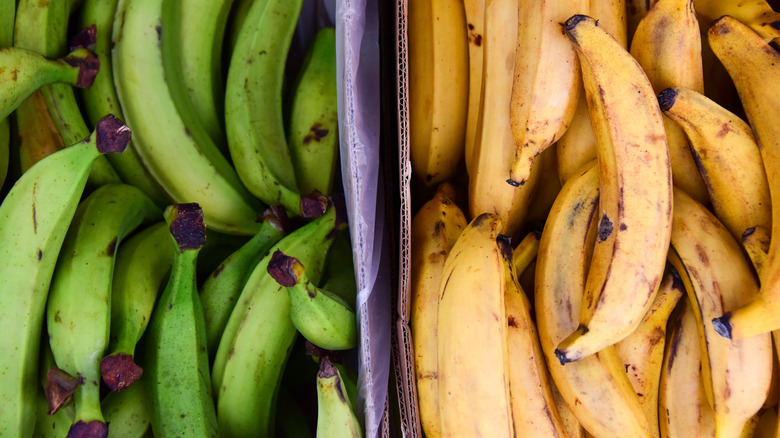Bananas Vs Plantains: What's The Difference?
It's easy to confuse bananas with plantains at the grocery store. After all, plantains are a member of the banana family Musaceae. At first glance, it's clear that these two are family members. Besides their shared crooked shape and bundled appearance, the two also signify their ripened state with a green-to-yellow transformation, and they tend to be found in similar sections of the grocery store.
But how can you properly tell the difference between a yellow banana and a yellow plantain? Well, much of the similarities between the two are only skin deep. One taste of either product will show you how discordant the two are, not unlike comparing sugary apples to starchy potatoes. This flavor divergence has also affected how the two fruits are cooked, not to mention what spices and dishes they're paired with. As we break down the many cultural, ecological, and physical differences between plantains and bananas, you'll begin to understand the distinct beauty of each fruit.
What is a banana?
First, let's talk about all things bananas. While they can be grown anywhere, bananas are mostly exported from countries in Asia, Africa, and Latin America. These areas often have very low labor costs, which makes bananas one of the cheapest and most popular fruits on the market. The fact that they're easier to grow and less perishable than other fruits like berries also helps keep prices low. At home, it's best to store your unripe bananas in a cool, dry place on the countertop, while ripe bananas should be stored in the fridge.
Incidentally, most of the modern bananas you find at the grocery store are actually one particular variety. Known as the Cavendish banana, this type of banana came into popularity after replacing the dying Gros Michel banana back in the twentieth century. Ironically, the same fungus that wiped out the Gros Michel, the Panama Disease, is now a threat to the Cavendish variety.
Though this popular fruit is harvested when green, people don't typically eat it until it's yellow and ripe. As bananas ripen, enzymes turn the starch into sugars and the pectin that keeps your fruit firm begins to relax and weaken, transforming the banana into a creamy and sweet treat. This ripening process will continue indefinitely, with your banana getting sweeter and mushier every day. The ethylene gas produced during this process will also turn your banana skin from yellow to brown to black.
What is a plantain?
Grown year-round, the plantain is an essential crop for tropical areas like Uganda, Rwanda, Peru, and Myanmar, to name a few places. At first glance, plantains are characterized by a large shape and tough skin. On the inside, plantains pack quite a starchy interior, making them seem more like a potato rather than a fruit. Also harvested when green, plantains are best kept stored in a cool, dry place after purchase.
Plantains are exceptionally versatile, as they can be eaten when they're ripe or unripe. Ripe plantains are sweet and perfect for pan frying, as the sugars will caramelize in a hot skillet. In fact, sweet fried plantains are a classic side dish to savory meals in Caribbean, Latin American, and South American cuisines, taking a particularly tasty role in Peruvian seafood platters. Unripe plantains, on the other hand, are mild and starchy, making them the ideal blank canvas for salty and spicy flavors. Chefs can turn them into dishes like tostones, also known as fried green plantains. You can even boil, peel, and eat a green plantain like you would a plain potato.
The main difference between these fruits
While bananas and plantains might resemble one another at first glance, they couldn't be more different. To start with, plantains are bigger and have a tougher skin than bananas. In terms of internal texture, bananas are soft, while the high starch content in plantains makes them more tough and tacky, no matter their stage of ripeness. This increased starch content — unripe plantains pack 9% starch while bananas only have 1% — also makes plantains higher in calories and carbs.
In terms of use, bananas are generally only used when ripe to eat, working as a raw snack or as a sweet addition to desserts and baked goods. Meanwhile, plantains are more versatile and can be used whether ripe or unripe and for savory or sweet dishes. Still, plantains are not commonly eaten raw due to their tough textures, and even sweet plantain dishes tend to be mostly served as an accompaniment to savory meals.
Finally, these fruits tend to be grown and exported from vastly different sources. While both bananas and plantains can be grown worldwide, African countries tend to grow the most plantains, while India and China dominate the global banana business.



